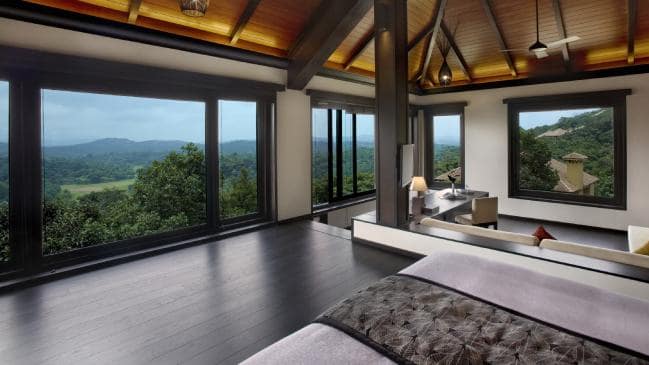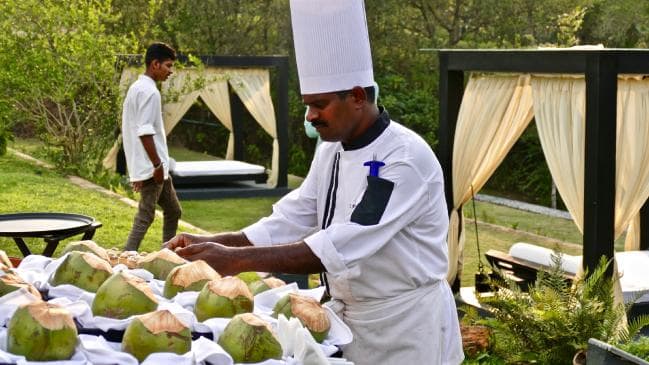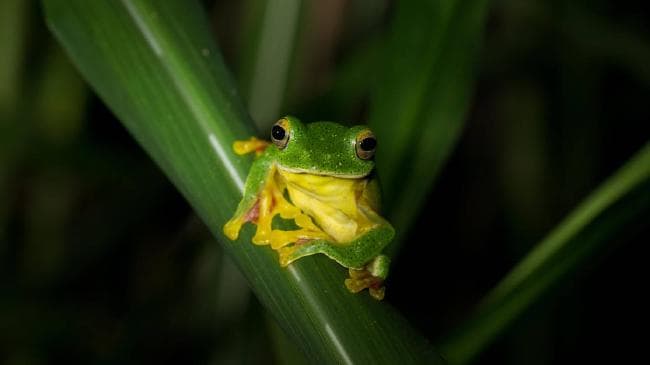Unexpected wonders abound when immersed in the Coorg culture of southern India.
A thunderclap heralds the first, early rains of the monsoon season minutes after my arrival in the misty highlands of Coorg in southern India. From the deck of the Taj Madikeri Resort and Spa, cantilevered over a seemingly infinite valley, I have a dress-circle view of the approaching stormfront and rolling peaks silhouetted to the horizon. Swallows pirouette as front office manager Anant Marwah describes the coming wet season, when clouds billow into the open foyer and pass through the body like shivers. “You should see the monsoon — it’s amazing,” he says. “Mother Nature does most of the work here.”
Despite its name the resort is not, in fact, in Madikeri, the hill-station capital of Coorg district in Karnataka state. This is frustrating because I’d hoped to be staying in the heart of the land eulogised by Irish writer Dervla Murphy for its sacred forests and coffee-scented hills. But my disappointment is short-lived. The property, 1200m above sea level and 9km from Madikeri down a broken road flanked by rice paddies and the odd azure kingfisher, turns out to be a microcosm of Coorg culture.

Its 63 cottages and villas, carefully built over seven years to minimise disruption to the landscape, sit cloistered in 12ha of rainforest and coffee plantations. Constructed from recycled timbers and bricks made on-site from marsh soils (the quarry is now a pretty lake between the herb garden and main pool), the cottages’ external walls are coated in natural mud paint so as not to disturb wildlife. Pitched-roof interiors feature vast, screened windows over the semi-wilderness, fireplace snugs and fish-trap decorations woven by local tribal people. Barking deer stalk the grounds at night.
But it is the indigenous Kodava staff who give the hotel its strongest character and meaning. Colonel Pattamada Muthana, retired, commutes daily from Madikeri to the hotel’s onsite “conservatory”, a compact museum where he shares his people’s story with guests. Displays depict Coorgi dress, marriage rituals, faith and other traditions.
Dressed in camel corduroys, braces and impeccably polished boots, his kind face framed by specs and a faintly regimental moustache, Colonel Muthana explains how the Kodava view themselves as a distinct tribe, despite not being recognised as such by the Indian government.
“For some reason we were not scheduled, maybe because nobody knows our origin,” he suggests. But many Kodava suspect their ancestors were followers of Alexander the Great, who fled here after the Macedonian king’s failed bid to conquer India.
Guide Amaanda Pradhan Poovanna, known as Pradhan, picks up the Kodava creation story during a dawn hike to the top of Nishani Peak.
“It’s still believed we don’t belong to India, that we are descendants of Persians,” he explains as we pass by tiger pug marks, perhaps a week old, on the track.
The Kodava language, a hybrid of southern tongues and about 200 Persian words, and their distinctive features set them apart from other Indian peoples. “The ladies are fairer and they have blue eyes. The men have broader noses and curly hair, and most of them are from the warrior race.”

Kodava men often seek army careers. “If there are two sons, one will definitely be in the army,” Pradhan explains. “The other will be in sports. I am the only son, so my parents didn’t let me join the army. But I play hockey, for 15 years now.”
The cries of jungle fowl and yellow-throated bulbuls greet us as we emerge from a shola grove on to a grassy summit with a mesmerising sweep of highland scenery.
“What you are breathing is the purest oxygen, totally unpolluted,” he grins. I learn so much from Pradhan about life in Coorg (also known as Kodagu in post-colonial India), from the timing of the harvest calendar — cardamom in October, arabica coffee berries and rice in November-December, robusta berries in January, pepper in March — to the local diet of smoked boar meat and booze.
The Kodava are keen and resourceful drinkers, making wine out of everything from coffee to bird’s-eye chillies. “Without liquor and meat nothing happens in Coorg,” Pradhan assures me.
Privileged access and insights into local traditions are hallmarks of my 10-day, tailor-made swing through South India with Adventure World Travel. Even if I had been staying in the heart of Madikeri, I can’t imagine understanding the region as well as I do within the confines of the Taj resort.
Every aspect of the hotel is steeped in Coorgi culture, from ritual gudda baths of wood-heated local water rich in minerals and fragrant with lime leaves, to the seasonal and regional menus of executive chef Jose Thachil. Hel hails from neighbouring Kerala so is well versed in South India’s spice bounty of pepper, cloves, cardamom and kokum that has lured Roman, Greek and Arab traders to the Malabar Coast since ancient times. He prepares fish steamed in cardamom leaves and pork slow-braised in a cocktail of spices and laced with syrupy black kokum vinegar, a staple Kodava condiment so tart it makes the cheeks flinch.
On a nature walk through some of the resort’s 70ha green belt, Pradhan shares his ancestral knowledge of forest medicines.
Wild tobacco is used on the skin as a leech repellent during the monsoon. Peppercorns and basil are blended into a paste to “keep the throat clear”; Brahmi leaves are considered very good for children’s hair and memory. “If you eat one Brahmi leaf, one basil leaf and one neem leaf every morning, you will stay away from all the diseases,” he says.
There are thousands of wild elephants in these hills, though we see none. Leopards also prowl the highlands, and king cobras, the world’s largest venomous snake, come in XL sizes here. The biggest one discovered to date was 8m long.

Above us, flying lizards, frogs and squirrels have adapted to life in the treetops. Frogs thrive in the annual six-month monsoon, from May to October. The Malabar gliding frog is just one of more than 40 species, which include dancing frogs and purple frogs. Mushrooms are abundant too, including a fluorescent green fungus that switches on and off like a light. Only four of the 400 types are edible and Kodava children are taught to tell them apart from an early age.
We trace the boundary of a sacred grove where a temple dedicated to the fearsome Kali, goddess of destruction, protects the wilderness from trespassers.
These devara kadu, or “forests of the gods”, were once common across India but succumbed gradually to agriculture and development. They persist in the south, particularly in Kerala and Coorg, where, says Pradhan, “we value the importance of the wildlife and forests because they give us food, oxygen and rainfall”. He opens my eyes to Coorg’s charmed surroundings. After dinners I sit outside my jungle house in the blackness as fireflies blink brightly all around me.
Insect orchestras with frog percussion sections serenade me to sleep each night. The sweet song of the Nilgiri coucal and the dirge of the tone-deaf Malabar whistling thrush wake me at sunrise.
On the last morning, bags packed and waiting for a jeep to collect me, I’m taking one last, deep draught of my surroundings when something crashes into the tangle of branches outside my windows. I step closer to see what it is and stand eye-to-eye with a Malabar pied hornbill. It looks as shocked as I do to find itself so close to such an exotic creature, and stays frozen in a bid to blend into its surroundings. This is not easy when you are a large black bird with an enormous yellow bill and casque, so we just stand there, staring at each other, in a fitting farewell to an adventure defined by unexpected wonders.
Kendall Hill was a guest of Adventure World Travel and Taj Madikeri Resort & Spa.
In the Know
Adventure World Travel tailors holidays, from flights to accommodation and experiences. Its 11-night South India itinerary from Chennai to Bangalore via Tanjore, Hyderabad, Bekal and Coorg includes stays at members of the luxury Taj Hotels group, breakfasts, internal flights, tours and activities, all transfers and sightseeing by minibus. From $7295 a person twin-share.
Singapore Airlines has excellent connections between eight Australian cities and South India, flying to Chennai, Bengaluru, Hyderabad and Kochi via Singapore.
• adventureworld.com.au
• tajhotels.com
• singaporeair.com
_______________________________________
source: http://www.theaustralian.com.au / The Weekend Australian / Home> Travel / by Kendall Hill / August 31st, 2019

